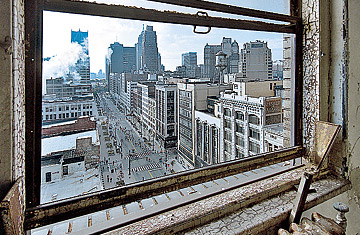
View of downtown Detroit through a window of the Broderick Tower on Woodward Avenue, 2005.
(2 of 5)
But to a native, downtowns and suburbs, even suburbs hurting from an economic calamity, are not the real Detroit. The Detroit I both wanted to see and was afraid to see was the city itself, the elm-lined streets of fond memory where my friends and I grew up and went to school and lived idyllic 1950s lives, the place that America once knew as the Arsenal of Democracy.
The neighborhood where I lived as a child, where for decades orderly rows of sturdy brick homes lined each block, is now the urban equivalent of a boxer's mouth, more gaps than teeth. Some of the surviving houses look as if the wrecker's ball is the only thing that could relieve their pain. On the adjacent business streets, commercial activity is so palpably absent you'd think a neutron bomb had been detonated--except the burned-out storefronts and bricked-over windows suggest that something physically destructive happened as well.
Similar scenes are draped across most of the city's 138 sq. mi., yielding a landscape that bears a closer relation to a postapocalyptic nightmare than to the prosperous and muscular place I remember. The City of Homeowners, some called it, a city with endless miles of owner-occupied bungalows and half-capes and modest mock Tudors that were the respectable legacy of five decades of the auto industry's primacy in the American economy and Detroiters' naive faith that the industry would never run out of gas.
But it did. Detroit fell victim not to one malign actor but to a whole cast of them. For more than two decades, the insensate auto companies and their union partners and the elected officials who served at their pleasure continued to gun their engines while foreign competitors siphoned away their market share. When this played out against the city's legacy of white racism and the corrosive two-decade rule of a black politician who cared more about retribution than about resurrection, you can begin to see why Detroit careened off the road.
Who Killed Detroit?
Most of us thought Detroit was pretty wonderful back in the '50s and early '60s, its mighty industrial engine humming in top gear, filling America's roads with the nation's signifying product and the city's houses and streets with nearly 2 million people. Of course, if you were black, it was substantially less wonderful, its neighborhoods as segregated as any in America. On the northwest side, not far from where I grew up, a homebuilder had in the 1940s erected a six-foot-high concrete wall, nearly half a mile long, to separate his development from an adjacent black neighborhood. Still, white Detroit believed that the riots that ravaged Los Angeles in 1965 and a number of other cities the following summer would never burn across our town. Black people in Detroit, enlightened whites believed, had jobs and homes, and even if those homes were on the other side of an apartheid wall, their owners had a stake in the city.
Some did, but too many others, invisible to white Detroit, did not. The riots that scorched the city in July 1967, leaving 43 people dead, were the product of an unarticulated racism that few had acknowledged, and a self-deceiving blindness that had made it possible for even the best-intentioned whites to ignore the straitjacket of segregation that had crippled black neighborhoods, ill served the equally divided schools and enabled the casual brutality of a police force that was too white and too loosely supervised.
